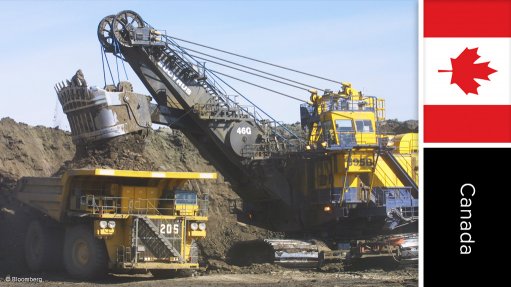
VANCOUVER (miningweekly.com) – The Canadian mineral and mining industry on Monday outlined six important policy areas it would like to see addressed during the seventy-fourth annual conference of federal and provincial ministers of energy and mining in Saint Andrews, New Brunswick, this week.
A national coalition of mining associations under the Canadian Mineral Industry Federation (CMIF) is recommending several government actions to help unlock billions of dollars of economic activity across the country, address climate change, bolster reconciliation efforts with indigenous peoples, and secure Canada as the world's top supplier of sustainably sourced minerals and metals in an increasingly lower-carbon global economy.
Critical policy issues include improving the regulatory process. According to the CMIF, it is critical that current reviews of the Canadian Environmental Assessment Act, the Fisheries Act and the Navigation Protection Act result in an effective, timely and coordinated regulatory process, from pre-environmental assessment (EA) to post-EA permitting, with meaningful consultation.
Industry wants to see increased support enabling indigenous participation in the mining sector. The CMIF suggested that governments can further enhance the participation of indigenous peoples in mining through investments in health, education and skills training, and implement government resource revenue-sharing mechanisms. Building on strengths, government should leverage industry as a platform to advance meaningful indigenous economic reconciliation.
Miners would also like to see an effective climate change policy being implemented, that can lead to meaningful emissions reductions while enabling the Canadian economy to grow. It needs to be carefully designed to ensure the competitiveness of emissions-intensive and trade-exposed (EITE) sectors, like mining. Failing to protect EITE sectors will lead to mineral production moving to competitor countries with less stringent climate change policies, the CMIF stated.
The country’s mining industry also implored lawmakers to carefully consider land use and withdrawals. According to the CMIF, Canadian governments should ensure that mineral potential is factored into all land withdrawal decision-making processes, and that land-use planning and withdrawal decisions are balanced, and made through systematic and structured processes.
Further, Canadian mines in remote locations need governments to address the costs of exploring and mining in the far north, since the future of Canada's mineral industry lies increasingly in remote and northern regions, and the current infrastructure deficit acts as a major barrier to opportunities for greater wealth discovery and production. The CMIF supports the creation of the Canada Infrastructure Bank and encourages the federal government to ensure that it has a pathway for remote and northern Canada, including infrastructure projects that benefit industry, as well as local and indigenous communities.
To help Canada become the leading supplier of sustainably sourced minerals and metals, as well as the technologies the world needs to best extract them, government and industry collaboration is needed. This includes government support for the proposed CLEER (Clean, Low-energy, Effective, Engaged and Remediated) Clean Resources Innovation Supercluster, led by the Canada Mining Innovation Council and the Centre for Excellence in Mining Innovation.
The CMIF is a collaboration of national, provincial and territorial associations representing various sectors of the Canadian mineral industry. It is supported by both the Mining Association of Canada and the Prospectors and Developers Association of Canada.